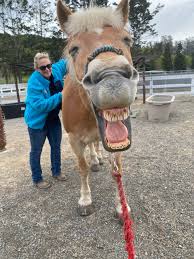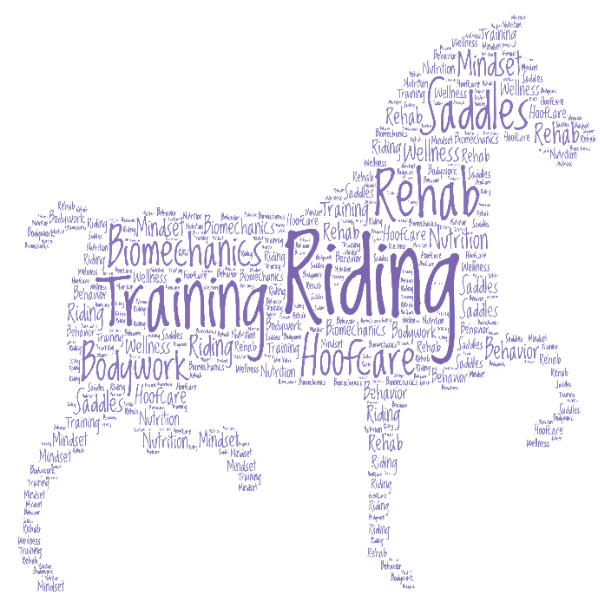The Horse’s Diaphragm – More Than Just a Breathing Muscle
By Tamara Elkayam
I have been playing with diaphragms in the last two weeks and changing my approach to them with some amazing results. Breath is the hinge on which the door of life swings.
Before I start, let’s make it clear the horse’s diaphragm is involved in all the bodies systems and it would be impossible for me to cover them all . As always the concept here is to simplify extremely complicated connections in the body in order to bring awareness and open a discussion.
THE DIAPHRAGM
The diaphragm is a dome-shaped musculotendinous sheet separating the thoracic and abdominal cavities. It is convex on its cranial surface. The muscular part of the diaphragm is peripheral, surrounding the central tendinous area.
During inspiration, the diaphragm contracts to increase the volume of the thoracic cavity, decreasing its pressure, thus drawing air in. The diaphragm relaxes for expiration. The diaphragm is more than a muscle for respiration, it is THE PUMP for the entire body!
THE PHRENIC NERVE
The phrenic nerve is a nerve which passes down between the lung and heart to reach the diaphragm. It is important for breathing, as it passes motor information to the diaphragm and receives sensory information from it and the peritoneal fascia. There are two phrenic nerves, a left one and a right one. The phrenic nerve is formed from cervical nerve fibers 4,5 &6. The phrenic nerves contain motor, sensory and sympathetic nerve fibers.
The phrenic nerve also innervates the peritoneal fascia surrounding all the organs caudal to the diaphragm.
THE VAGUS NERVE
The vagus nerve (again there are two nerves, one on each side of the body) is the cranial nerve that connect the brain to the body. It allows the brain to monitor and receive information about several of the body’s different functions. Vagus nerve, also called X cranial nerve, the wandering nerve, is the longest and most complex of the cranial nerves.
The vagus nerve helps control and regulate the heart rate and keep the gastrointestinal tract in working order. The vagus nerve also carries sensory information from the internal organs back to the brain. The vagus nerve is also known as an inflammatory nerve.
The vagus nerve runs through the crural region of the horse’s diaphragm, innervating this area. Here again we can see how the diaphragm has fascial and neurological connections that have body wide implications.
 THE VAGOSYMPATHETIC TRUNK
THE VAGOSYMPATHETIC TRUNK
The sympathetic trunk is a fundamental part of the sympathetic nervous system and part of the autonomic nervous system. Sympathetic trunk is formed from two long ganglionated nerve strands, the Vagus nerve and the Laryngeal nerve, one on each side of the vertebral column extending from the base of the skull. Each trunk is part of the sympathetic nervous system and consists of a series of ganglia connected by various types of fibers.
Research in humans has found that these symptoms can be linked to a dysfunctional diaphragm.
- Irritable bowel syndrome – think of those horses that have unexplained intermittent diarrhea or colic frequently.
- Chronic lower back pain – most horses have lumbar pain at some point.
- Chronic pelvic pain – most horse have some pelvic discomfort and /or SI issues
- Chronic headache – most horses get headaches.
- Temporomandibular joint dysfunction – I can count the number of horses I have treated that DO NOT fall into this basket on two hands.
- Depression and anxiety – weavers , cribbers, spookers, the angry horses and the dead broke bomb prof horses.
CONSIDER THE TACK
It is important to remember how we affect the horse neurologically and physiologically by tacking up a horse and riding ; essentially we sit on their diaphragm.
The diaphragm is attached to the ribs,each rib has two heads and coasta cartilage. The diaphragm is suspended from rib 9 to 18 , its dorsal attachment is T17/18 to L4 that is also the site of Psoas attachments where they share fascia, in fact if we keep following the fascia we will end up in the sacrum.
On the cranial portion of the diaphragm there is a very strong fascial connection to pericardium which attached to the visceral fascia of esophagus and trachea all the way up to the hyoid.
We use bits and apply pressure to the tongue and the lingual pallet of the hyoid apparatus affecting breathing by controlling their head position. We flex the poll, applying pressure on nerve ganglion.
We use tie downs of various shapes and positions to keep the horse in frame and by doing so, affect the neck muscles and the breathing ; everything we do interacts with the horses diaphragm.
SO WHAT NOW?
You keep riding but when you tack up, you pay attention to the small cues your horse gives you. When working with your horses, really look at them; consider what their body is telling you.
So how do we keep the door swinging? By addressing the horse’s body, by using correct training and by using well fitted tack. We help them breathe better by greasing the hinges and supporting the door, we think about what is happening when we girth up, we acknowledge that a painful back or a girthy horse can have a bigger problem.
I know this is a lot of information but take away is this simple, everything we do affects the doors ability to swing.







1 Comment. Leave new
I have a mare that ha symptoms pointing towards diaphragm dysfunction. I have started her on herb therapy and was directed on a stretching exercise for her diaphragm. She also uses a saddle custom fit for her back. Any other suggestions that may help?